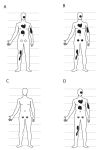Genetic mosaics and the germ line lineage
- PMID: 25898403
- PMCID: PMC4488662
- DOI: 10.3390/genes6020216
Genetic mosaics and the germ line lineage
Abstract
Genetic mosaics provide information about cellular lineages that is otherwise difficult to obtain, especially in humans. De novo mutations act as cell markers, allowing the tracing of developmental trajectories of all descendants of the cell in which the new mutation arises. De novo mutations may arise at any time during development but are relatively rare. They have usually been observed through medical ascertainment, when the mutation causes unusual clinical signs or symptoms. Mutational events can include aneuploidies, large chromosomal rearrangements, copy number variants, or point mutations. In this review we focus primarily on the analysis of point mutations and their utility in addressing questions of germ line versus somatic lineages. Genetic mosaics demonstrate that the germ line and soma diverge early in development, since there are many examples of combined somatic and germ line mosaicism for de novo mutations. The occurrence of simultaneous mosaicism in both the germ line and soma also shows that the germ line is not strictly clonal but arises from at least two, and possibly multiple, cells in the embryo with different ancestries. Whole genome or exome DNA sequencing technologies promise to expand the range of studies of genetic mosaics, as de novo mutations can now be identified through sequencing alone in the absence of a medical ascertainment. These technologies have been used to study mutation patterns in nuclear families and in monozygotic twins, and in animal model developmental studies, but not yet for extensive cell lineage studies in humans.
Figures


References
-
- De Felici M. Origin, Migration, and Proliferation of Human Primordial Germ Cells. In: Coticchio C., Albertini D.F., de Santis L., editors. Oogenesis. Springer-Verlag; London, UK: 2013. pp. 19–37.
-
- Eddy E.M., Clark J.M., Gong D., Fenderson B.A. Origin and migration of primordial germ cells in mammals. Gamete Res. 1981;4:333–362. doi: 10.1002/mrd.1120040407. - DOI
Publication types
LinkOut - more resources
Full Text Sources
Other Literature Sources

